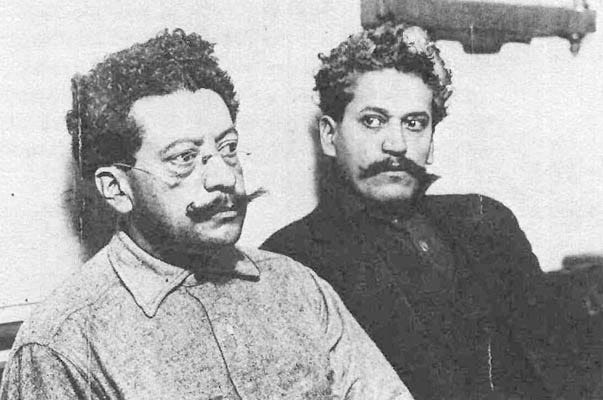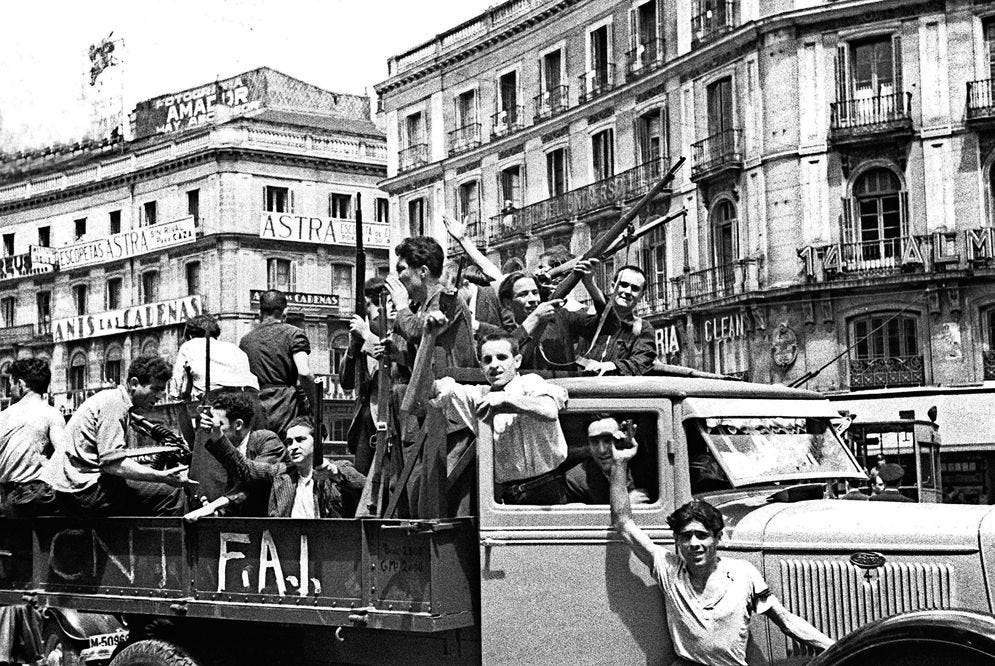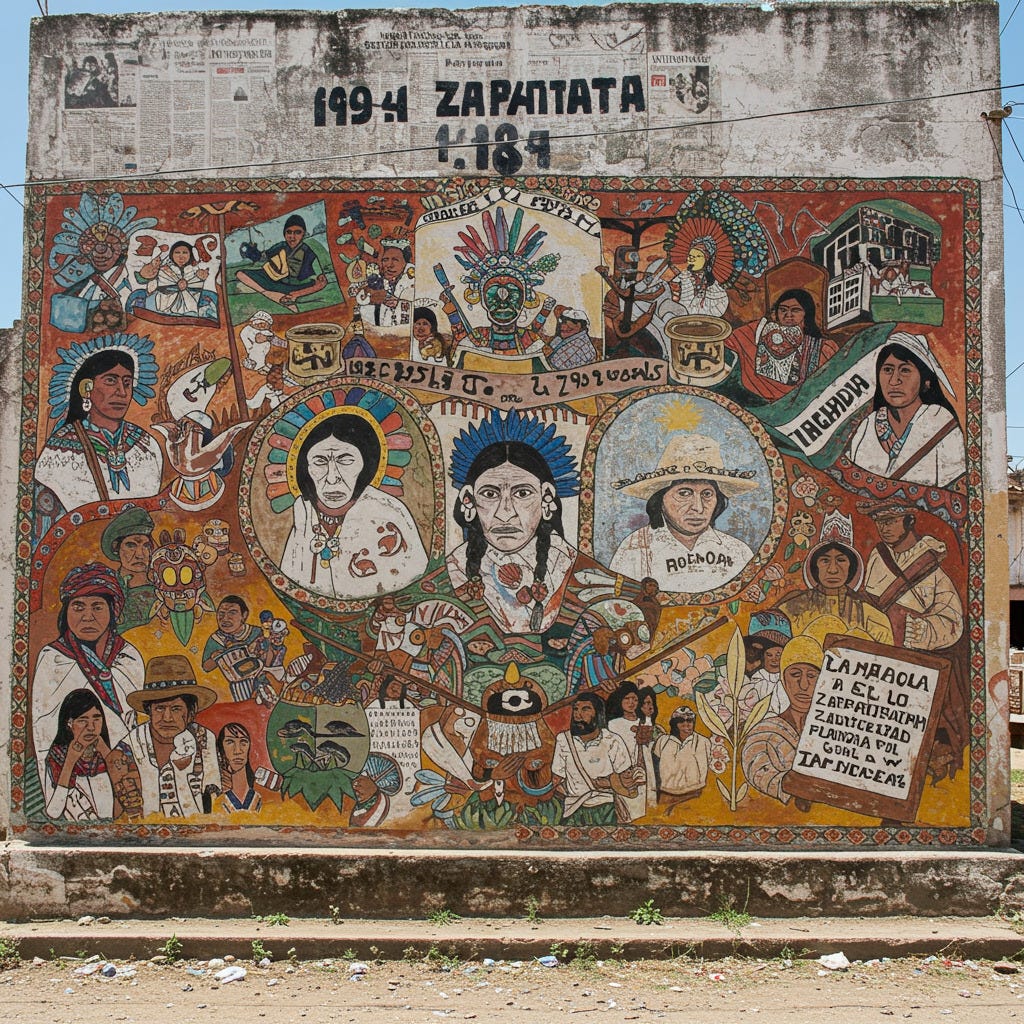
The election of Zohran Mamdani as mayor of the United States’s largest city is proof that socialism is no longer a dirty word for the liberal left. Marxist-Leninist micro-parties are recruiting across the country. On the right, Nazi-sympathizing groypers are staffing congressional offices in Washington. The iron hegemony of liberal democratic, capitalist ideology has been definitively broken in the heartland of the nation that exported it around the world at gunpoint.
So why is anarchy still a dirty word in many circles?
Since anarchy is commonly understood to be a state of no-rules disorder, anarchism seems like the advocacy of chaos as a political platform. This fits well with the image of the anarchist as a misguided, rebellious child as well as an older stereotype of anarchists as foreign, bomb-throwing lunatics.
But we shouldn’t write off a political tradition just because of the preconceptions promoted by its opponents, particularly when such images are clouded by ageism and xenophobia. You don’t have to call yourself an anarchist, but if you are committed to the positive transformation of the world, you do yourself a disservice by writing off the entirety of the anarchist tradition and movements based on hearsay.
Today, we’re breaking down what anarchism is, as a tradition, as a strategy, and as a practice.
Anarchism as tradition
As an explicit political ideology, anarchism stands as “one of the modern world’s oldest, if little remembered, political and intellectual traditions.” Anarchism is older than, say, Marxism, fascism, or libertarianism, and is just a few decades behind liberal capitalist electoral democracy. Of course, if the age of a doctrine were a guarantor of its objective truth, we’d all have to proponents of absolute monarchy and, like, Zoroastrianism.
But along the way, anarchism has played a pivotal role in successful revolutions from Mexico to the Philippines. It’s found adherents from authors like Leo Tolstoy and Henry David Thoreau to pivotal movement leaders like veterans of the Black Liberation Army and the nascent American labor movement. Serious thinkers and dedicated revolutionaries have engaged with anarchism, and not because they were secretly advocates of violent chaos.
Rather than promoting chaos, anarchism critiques hierarchy and authority: the power of men over women, bosses over workers, and rulers over the ruled, to name a few. This means rejecting coercive social systems like patriarchy, coercive economic systems like capitalism, and coercive political systems like the state.
None of these systems are innately human or unchangeable. If you think sexism is an immutable fact of the human condition, congratulations, you’re a far-right zealot! But the idea of doing away with the state in particular often strikes people as particularly outlandish—despite the fact that patriarchy predates the modern nation-state system by several millenia.
As anarchist social scientists from Elisee Reclus to the late David Graeber have shown, people like in complex societies of all varieties. There are people living in non-state societies right now in 2025, and many more with vanishingly rare contact with state authorities. Similarly, we practice mutual aid–a concept developed by the revolutionary anarchist movement–even under capitalism. If the systems of oppression and domination we live under aren’t natural or inevitable, why would we not want to live differently?
In the words of anarchist sympathizer Ursula K. LeGuin:
We live in capitalism, its power seems inescapable — but then, so did the divine right of kings. Any human power can be resisted and changed by human beings.
Anarchism as strategy
Anarchism isn’t alone in advocating for a classless, stateless society. Anarchism emerged alongside Marxism as the two revolutionary poles of the 19th-century workers’ movement. Marxists, like anarchists, aspire to a society without either government or exploitative class relationships as the ultimate goal of revolutionary struggle.
The difference between revolutionary Marxism and anarchism concerns not the final objective but rather the best strategic means for attaining it. (In other words, if you think a stateless society is laughable, you also are disqualified from being a Marxist.) Marxists and anarchists also generally share an analysis of the state being the enforcer of class relationships. Just like the feudal state protected the privileges of the nobility, they both view the capitalist state as being the guarantor of the rule of the owning elite. The whole difference between Marxism and anarchism is about how to best transition from this current state of affairs to the no-government, no-exploitation social order that is a shared goal.
Painting with an admittedly broad brush, Marxists generally believe that we can’t achieve a classless, stateless society without passing through a period where the state is run by representatives of the working class. This workers’ state will root out capitalist social relations before withering away together with the vestiges capitalism. Anarchists are suspicious that state power can be used to dismantle capitalism or, for that matter, itself.
This doesn’t mean that anarchists think we can transition to communism overnight. It also doesn’t mean that anarchists necessarily reject the idea of revolutionary social organization. Anarchists are critical of the belief that government is the specific form of revolutionary social organization that can uproot exploitation for good. And the history of revolutionary statism gives plentiful reasons to doubt the Marxist account.
During the twentieth century, self-proclaimed workers’ governments ruled approximately one-third of the earth. The governments of countries like North Korea and Laos show no signs of “withering away” despite decades of one-party rule. Rather, socialist governments have provided the basis for new forms of class inequality, with ruling party members and their families receiving preferential access to housing and education. In countries like China and Vietnam and the former USSR, rather than managing the progression towards communism, socialist governments have overseen the partial or complete restoration of capitalist relations. Regime apologists retort that these countries are in fact moving through the “primary stage of socialism.” If this is true, socialism features many of the worst features of capitalism: sweatshops and labor abuses, dispossession of workers and peasants, and the construction of export-oriented economies oriented towards serving the US consumer market.
Empirical evidence that socialist governance allows for the maintenance of class relations and can even shepherd the return of capitalist economies gives credence to anarchist suspicions about the utility of the state for revolutionary transformation. Anarchism provides a revolutionary anti-capitalist tradition that incorporates the lessons of the mass movements of the twentieth century as we work towards crafting a better world.
Anarchism as practice
The account we’ve seen so far situates anarchism in the labor movement of Western Europe and the Americas. Together with the fact that anarchism has found refuge in majority-white punk subcultures, this does little to argue against the common conception that anarchism is a “white people thing.”
But some of the strongest anarchist movements today are fighting in Africa, Latin America, and Asia. And beyond explicitly self-described anarchist movements, many have identified anarchic practices emerging from oppressed communities for the very reason that oppressed peoples can’t count on representation by the state.
As Zoé Samudzi and William C. Anderson write in “The Anarchism of Blackness”:
Blackness is, in so many ways, anarchistic. African-Americans, as an ethno-social identity comprised of descendants from enslaved Africans, have innovated new cultures and social organizations much like anarchism would require us to do outside of state structures. Black radical formations are themselves fundamentally anti-fascist despite functioning outside of “conventional” Antifa spaces, and Black people have engaged in anarchistic resistances since our very arrival in the Americas.
As I’ve previously written here, I’ve made an analogous point in my book on anti-gentrification social movments, Defying Displacement:
I argue that oppressed communities that are skeptical of political representation, fighting capitalist exploitation, and struggling for survival and self-determination might not be anarchist but are certainly doing anarchism. This is what I call the “anarchism of praxis,” a practical anarchism that’s not reflected in doctrinaire ideologies and subcultural norms. Its protagonists might describe their beliefs in any number of ways. It grows out of, not waits to be extended to, the “inherently anarchistic element” of those who are displaced first: the Black, Indigenous, and immigrant communities already “residents in” and not “citizens of” the United States. The anarchism of praxis is the practice of survival for those targeted for removal by capital and the state.
Oppressed communities often adopt anarchic practices in response to state oppression and neglect: mutual aid and collective organization, mistrust of politicians and bosses and the police. We can think of anarchism as the promotion and connection of such actually-existing practices as part of a strategy of revolutionary transformation.
What anarchism isn’t
As I’ve described it, anarchism isn’t the promotion of violence, chaos, or disorder. It isn’t the naive belief that we can birth a fully-formed utopia at the flick of a switch, and it doesn’t necessarily imply the wholesale rejection of revolutionary organization or discipline. Anarchism also isn’t the exclusive property of any one community or subculture.
In fact, anarchism represents a rich heritage of resistance around the world. It’s a heritage that everyone who’s fighting for a better world could benefit from engaging with earnestly and seriously, whether you’d ever call yourself an anarchist or not.
And, in the words of David Graeber:
Anarchists are simply people who believe human beings are capable of behaving in a reasonable fashion without having to be forced to. It is really a very simple notion. But it’s one that the rich and powerful have always found extremely dangerous.
Read more:
Anarchism and Its Aspirations (Cindy Milstein)
Anarchism and the Black Revolution (Lorenzo Kom’boa Ervin)
As Black as Resistance (Zoe Samudzi and William C. Anderson)
Fragments of an Anarchist Anthropology (David Graeber)
Mutual Aid (Dean Spade)
To Change Everything (CrimethInc)
This post has been syndicated from In Struggle, where it was published under this address.




